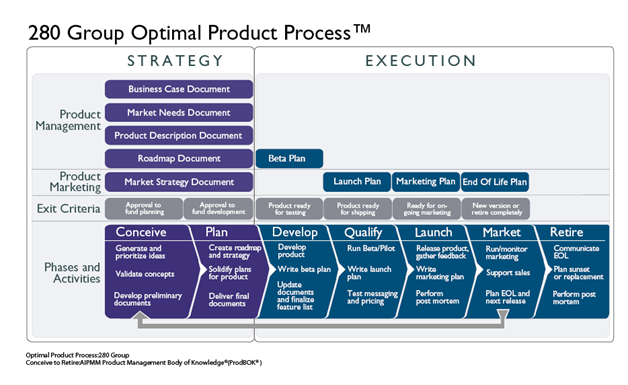The opinions expressed by the bloggers below and those providing comments are theirs alone, and do not necessarily reflect the opinions of Ryma Technology Solutions. As they say, you can't innovate without breaking a few eggs...
Webinar Recap: The Seven Phase Standard Product Management Lifecycle
Here’s a recap for everyone who wasn’t able to attend today’s joint webinar between Ryma and the 280 Group (http://www.280group.com/blog ), presented by Brian Lawley.
The video and audio can be accessed here: http://grandview.rymatech.com/2012/208-the-seven-phase-standard-product-management-lifecycle.html
The slides can be accessed here: http://webinars.rymatech.com/webinars/20120307/rymaopp.pdf
Here’s a brief recap:
Optimal Product Process - A modern and flexible standard product development framework for highly-effective Product Management and Product Marketing.

This blog post is part of the new book, Optimal Product Process (http://tinyurl.com/productprocess,) and describes the seven phase AIPMM™ (Association of International Product Management & Marketing) product lifecycle as well as the 280 Group Optimal Product Process™. For several years now we have been hard at work on this process in order to help move the profession forward and create a framework that can be widely accepted and used. We hope you will find this project beneficial and useful in your own work.
THE AIPMM SEVEN PHASE PRODUCT LIFECYCLE MODEL
AIPMM developed a seven phase model that every product goes through (whether a company/team realizes it or not.) Oftentimes one or more of the phases are ignored, shortchanged or not focused on, resulting in a less-than-optimal result for the company and its customers. In many cases product management and/or product marketing are only involved in one phase, and no one is watching the “Whole Product” concept that the customer ultimately perceives as what they are buying. By being aware of and prepared for all seven phases, a company maximizes its chances for delighting its customers and increasing its profits.
The seven phase model is a uses a phase-gate approach. Each phase consists of standard tasks that must be accomplished, and then to move to the next phase a gate must be passed through. The gate is a decision based on the work in the phase as to whether the company wishes to move forward with the concept or product. By using this approach, the right information and data is gathered and analyzed and the risk of investing significant money or resources is managed appropriately.
It should be noted that although this is a phase-gate process (also sometimes referred to as waterfall), the notion of Agile development fits in and can be used effectively. When applying Agile development methods such as Scrum, Lean, etc. the company or team simply goes through the Plan, Develop and Qualify phases much more rapidly with a smaller set of features for each sprint (and less documentation required). They are still, nonetheless, doing required tasks in each phase and must pass through the corresponding gate, but may be able to do so more rapidly and efficiently.









The idea is that Ben inadvertently falls for her, and then must make his ultimate sacrifice for her. Dawson, to her credit, manages to set herself apart from Smith homage to wrongheaded heroism..